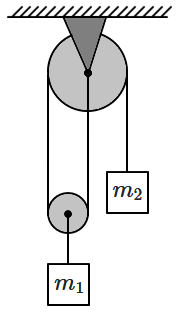Select Question Set:
A balloon ascending with an acceleration \(a\) has a ballast of mass \(m\) thrown out, and it is observed to move upward with double the acceleration. The mass of the remaining part (after the ballast is thrown out) is:

1.
\(m\dfrac{g+2a}{g+a}\)
2.
\(m\dfrac{g+a}{g}\)
3.
\(m\dfrac{g+a}{a}\)
4.
\(m\dfrac{g+2a}{g}\)
Subtopic: Newton's Laws |
52%
Level 3: 35%-60%
Hints
The two blocks \(A,B\) have identical masses and are placed on a smooth horizontal plane. The pulley \(P\) is light, and is rigidly connected to the block \(A\) by means of a horizontal light rod. The string connecting block \(B\) is also horizontal. A force \(F\) is acting vertically on the string, and the two blocks move horizontally. The force on \(A\) due to rod is:

1. \(F\)
2. \(2F\)
3. \(\sqrt2F\)
4. \(\dfrac{F}{\sqrt2}\)

1. \(F\)
2. \(2F\)
3. \(\sqrt2F\)
4. \(\dfrac{F}{\sqrt2}\)
Subtopic: Application of Laws |
56%
Level 3: 35%-60%
Hints
The two blocks \(A,B\) have identical masses and are connected by an ideal string. The block \(B\) lies on a smooth horizontal table with the connecting string horizontal and passing over a smooth light pulley. The relative acceleration of \(A\) with respect to \(B\) is:

1. \(g\)
2. \(\dfrac{g}{2}\)
3. \(\dfrac{g}{\sqrt2}\)
4. \(g\sqrt2\)

1. \(g\)
2. \(\dfrac{g}{2}\)
3. \(\dfrac{g}{\sqrt2}\)
4. \(g\sqrt2\)
Subtopic: Application of Laws |
Level 3: 35%-60%
Hints
The block \(A\) (mass: \(2\) kg) is placed on top of the block \(B\) (mass: \(1\) kg) and the combination is placed on a smooth horizontal table. The coefficient friction between \(A,B\) is \(\mu=0.2.\) What is the maximum horizontal force that can be applied to \(B\) so that the two blocks move together? (Take \(g=10\) m/s2)

1. \(8\) N
2. \(6\) N
3. \(4\) N
4. \(2\) N

1. \(8\) N
2. \(6\) N
3. \(4\) N
4. \(2\) N
Subtopic: Friction |
61%
Level 2: 60%+
Hints
A \(2\) kg brick is placed on the ground as shown and it is symmetrically cut into two equal pieces by a plane \(AB,\) which is at \(45^{\circ}\) with the horizontal. The system remains at rest. The force of friction on the upper piece due to the lower is: (Take \(g\) = \(10\) m/s2)

1. \(10\) N
2. \(10 \sqrt 2\) N
3. \(5 \sqrt 2\) N
4. \(5\) N

1. \(10\) N
2. \(10 \sqrt 2\) N
3. \(5 \sqrt 2\) N
4. \(5\) N
Subtopic: Friction |
59%
Level 3: 35%-60%
Hints
In the system shown in the figure, the strings and pulleys are ideal, and the block \(A\) moves downward while \(B\) moves to the right. \(A, B \) have equal masses. The acceleration of the block \(B\) is:


| 1. | \(\dfrac{g}{2}\) | 2. | \(\dfrac{g}{5}\) |
| 3. | \(\dfrac{2g}{5}\) | 4. | \(g\) |
Subtopic: Application of Laws |
Level 3: 35%-60%
Hints
Two smooth balls \(A,B \) of radius \(10\) cm each are placed in a cylinder of diameter \(30\) cm, as shown. The upper ball \((A)\) has a mass of \(2\) kg, while the lower ball \((B)\) has a mass of \(4\) kg. The system is at rest. Let the force exerted on the ball \(A\) by the cylinder be \(F_1\) along the horizontal (as shown) and that on the ball \(B,\) along the horizontal be \(F_2\) (as shown). Then:


| 1. | \(F_1 < F_2\) |
| 2. | \(F_1 = F_2\) |
| 3. | \(F_1 >F_2\) |
| 4. | the relationship between \(F_1\) and \(F_2\) depends on the mass of the cylinder |
Subtopic: Tension & Normal Reaction |
61%
Level 2: 60%+
Hints
Two blocks of weight \(1\) kg and \(2\) kg are placed in contact with each other on a smooth horizontal plane. Horizontal forces are applied to the blocks as shown. The blocks move together only if:

1. \(F\leq10\) N
2. \(F>10\) N
3. \(F\leq20\) N
4. \(F>20\) N

1. \(F\leq10\) N
2. \(F>10\) N
3. \(F\leq20\) N
4. \(F>20\) N
Subtopic: Application of Laws |
Level 3: 35%-60%
Hints
A constant force \(F\) is applied to the string so that the \(3\) kg block does not move, but the \(5\) kg block moves horizontally. The acceleration of the \(5\) kg block is: (take \(g=10\) m/s2)


| 1. | \(6\) m/s2 | 2. | \(3\) m/s2 |
| 3. | \(1.5\) m/s2 | 4. | \(1.2\) m/s2 |
Subtopic: Application of Laws |
71%
Level 2: 60%+
Hints
The system shown in the diagram is in equilibrium. Assuming that the strings and pulleys are ideal, the ratio of the masses, \(\dfrac{m_1}{m_2}=\)


| 1. | \(4\) | 2. | \(2\) |
| 3. | \(\dfrac{1}{2}\) | 4. | \(\dfrac{1}{4}\) |
a,
Subtopic: Application of Laws |
64%
Level 2: 60%+
Hints
Select Question Set:






